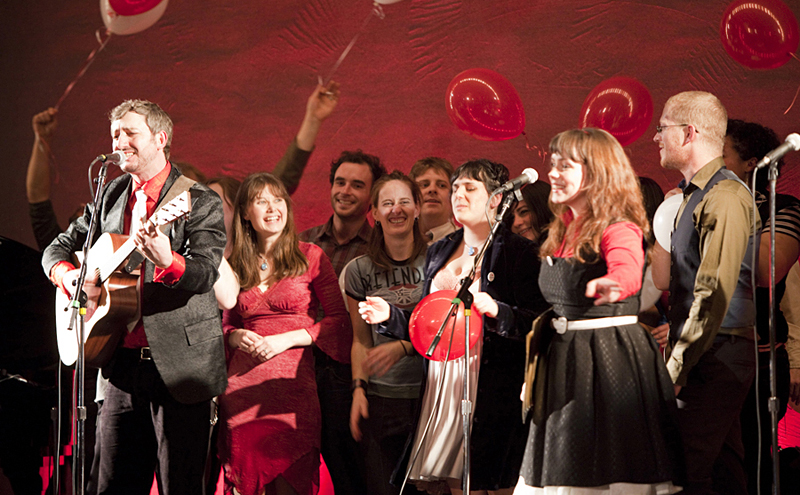The trio SuttonBeresCuller is nothing if not thorough and persistent. When they show up to discuss the status of their latest installation project, Mini-Mart City Park, members John Sutton and Ben Beres slap inches-thick stacks of municipal code onto the table. And the conversation revolves not around “art” so much as “Director’s rules,” “land-use permits,” and the dreaded Department of Planning & Development.
“We’re getting kind of tired of ‘click-click,’ ‘read-read,’ drag-drag,'” says Beres, mimicking the tedium of trying to make sense of city code, available online for those willing to brave it (www.seattle.gov/dpd). Rarely has there been a form of writing that straddles so successfully the line between matter-of-fact and what-the-fuck. (Example: An ordinance relating to land use and zoning, amending Title 23 of the Seattle Municipal Code (SMC) to consolidate land use code provisions on nonconformity, establish a new amnesty date for residential nonconformity…yadda yadda yadda, you get the picture).
Developers, architects, and engineers have some weird ability to process this information. But for the art trio, whose previous projects included a mobile trailer home and a habitable island floating in the middle of Lake Washington, it’s uncharted territory. Venturing there, however, is necessary for the group’s Mini-Mart project, which involves transforming an abandoned convenience store into a public green space. Though the trio could successfully pull off such a stunt without the city’s approval (it never stopped them in the past), Sutton claims that civic engagement is essential to this project.
“Oh, yes,” he says, with a raise of his eyebrows. “We want to be legit with this one.”
The concept is as old as the Monorail—or rather, the failed plan for a new monorail. In the early ’00s, certain segments of the city became enamored of the idea of running a monorail from Ballard out to West Seattle. The city even went so far as to buy up property to be designated as depots. One of those spots was the Sun Hill Mini- Mart on 85th Street and 15th Avenue in Crown Hill. When the monorail project issued a call for artists to put their individual stamp on these spaces during the lull before demolition and construction, SuttonBeresCuller put in a bid to make the old convenience store a public park.
“The idea was to take a look at our whole drive-up culture and fast-food culture,” says Sutton. “And give this whole space back to the community.”
Picture it: Folks would pull up to the pumps, tricked by the old façade, only to walk inside the Mini-Mart and be greeted by a park ranger and a building flush with foliage—mosses hanging from cigarette racks, ferns in beverage coolers, trees busting through the roof. What was once a patch of poisoned earth (known technically as a “brownfield”) would be home to native greenery serving to suck the toxins out of the soil.
It was a grand idea. Then voters shot down the monorail, and the Sun Hill Mini- Mart became a T-Mobile store.
An idea that good, however, does not die because of a vote. So SuttonBeresCuller started applying for funding, eventually landing a $50,000 grant from the New York–based Creative Capital foundation for a “temporary sculptural intervention.” “Then we started driving around,” says Sutton. “Scouting out abandoned mini-marts we could use, writing letters to the land owners basically saying ‘Hi! We want to use your land for a temporary art project.'” Needless to say, the letters met with little response.
But one man did respond with relative enthusiasm: the owner of a corner property at Ellis Avenue South and South Warsaw Street in Georgetown (who did not want to be named). While the structure on his lot was the most dilapidated of the ones SuttonBeresCuller scouted, the landowner said it would be three years before he did anything with it.
Even with a green light from him, though, there was the issue of proper permitting. The trio trekked up to the 21st floor of the Seattle Municipal Tower—the origin of all that city code—where they were told by a helpful-but-bewildered DPD employee: “We don’t really have land-use permits for temporary art installations.” On top of that, the Georgetown property, which was previously zoned commercial, had been recently rezoned for residential use only, which is more tightly regulated.
Still, the DPD was enthused by the project and agreed to meet with SuttonBeresCuller to figure out how to make it a reality. What they discovered, after wading through the muck of land-use code, is that the art project could in fact be permitted if passed off as a “community center.” “I mean, this is essentially something designed for the community,” says Sutton.
But then the trio discovered there was a church nearby, which is technically a community center, and city code mandates that community centers cannot be within 600 feet of each other.
“We were out there with the yardstick,” says Beres. “Measuring along the sidewalk, y’know: ’25 feet, 50 feet, 75 feet…'”
Sure enough, the Georgetown Gospel Church was less than 600 feet away, and all plans for Mini-Mart City Park came to a halt.
Currently, SuttonBeresCuller is in the middle of crafting an appeal to the city, basically outlining the harmlessness of the project and asking officials to simply let it slide without proper permitting.
But deep down, Sutton’s inner sadist—which has taken a mild pleasure in untangling bureaucratic jargon—has a loftier goal.
“After all this, I’d really like to see city code rewritten just because of this project,” he says with a laugh. “Imagine in the future seeing an amendment for temporary art installations in residential zones. That’d be really cool.”








